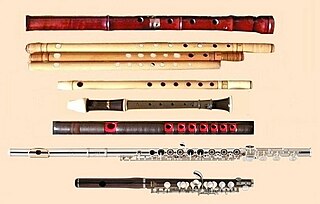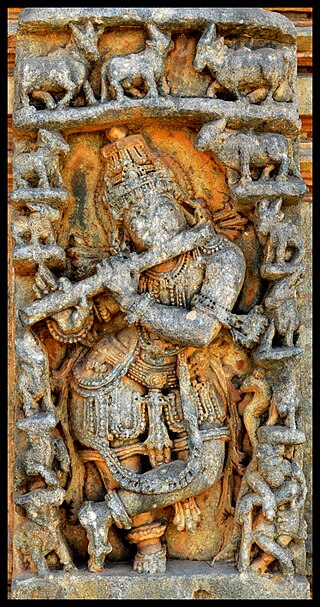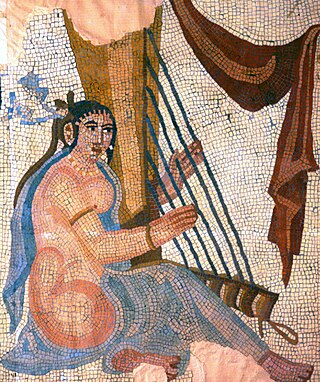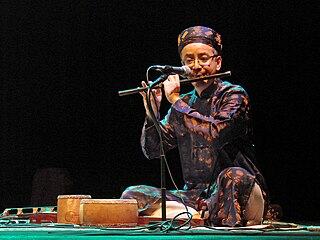Related Research Articles
The clarinet is a single-reed musical instrument in the woodwind family, with a nearly cylindrical bore and a flared bell.

The flute is a member of a family of musical instruments in the woodwind group. Like all woodwinds, flutes are aerophones, producing sound with a vibrating column of air. Unlike woodwind instruments with reeds, a flute produces sound when the player's air flows across an opening. In the Hornbostel–Sachs classification system, flutes are edge-blown aerophones. A musician who plays the flute is called a flautist or flutist.
A membranophone is any musical instrument which produces sound primarily by way of a vibrating stretched membrane. It is one of the four main divisions of instruments in the original Hornbostel-Sachs scheme of musical instrument classification.

An aerophone is a musical instrument that produces sound primarily by causing a body of air to vibrate, without the use of strings or membranes, and without the vibration of the instrument itself adding considerably to the sound.

The ocarina is a wind musical instrument; it is a type of vessel flute. Variations exist, but a typical ocarina is an enclosed space with four to twelve finger holes and a mouthpiece that projects from the body. It is traditionally made from clay or ceramic, but other materials are also used, such as plastic, wood, glass, metal, or bone.

The music of Afghanistan comprises many varieties of classical music, folk music, and modern popular music. Afghanistan has a rich musical heritage and features a mix of Persian melodies, Indian compositional principles, and sounds from ethnic groups such as the Pashtuns, Tajiks and Hazaras. Instruments used range from Indian tablas to long-necked lutes. Afghanistan's classical music is closely related to Hindustani classical music while sourcing much of its lyrics directly from classical Persian poetry such as Mawlana Balkhi (Rumi) and the Iranian tradition indigenous to central Asia. Lyrics throughout most of Afghanistan are typically in Dari (Persian) and Pashto. The multi-ethnic city of Kabul has long been the regional cultural capital, but outsiders have tended to focus on the city of Herat, which is home to traditions more closely related to Iranian music than in the rest of the country.

A bansuri is an ancient side-blown bamboo flute originating from the Indian subcontinent. It is an aerophone produced from bamboo and metal like material used in many Nepali Lok songs. A bansuri is traditionally made from a single hollow shaft of bamboo with seven finger holes. Some modern designs come in ivory, fiberglass and various metals. The six hole instrument covers two and a half octaves of music. The bansuri is typically between 30 centimetres (12 in) and 75 centimetres (30 in) in length, and the thickness of a human thumb. One end is closed, and few centimeters from the closed end is its blow hole. Longer bansuris feature deeper tones and lower pitches. The traditional design features no mechanical keys, and the musician creates the notes they want by covering and uncovering the various finger holes.

The bamboo flute, especially the bone flute, is one of the oldest musical instruments known. Examples of Paleolithic bone flutes have survived for more than 40,000 years, to be discovered by archaeologists. While the oldest flutes currently known were found in Europe, Asia too has a long history with the instrument that has continued into the present day. In China, a playable bone flute was discovered, about 9000 years old.

The pungi, bīn or Murli is a musical instrument that originates from the Indian subcontinent. The instrument consists of a reservoir into which air is blown and then channelled into two reed pipes. It is played with no pauses, as the player employs circular breathing. In street performances, the pungi is used for snake charming.

Music of Jammu and Kashmir reflects a rich musical heritage and cultural legacy of the Indian-administered union territory of Jammu and Kashmir. Two different regions of Jammu and Kashmir consists the Jammu region and Kashmir Valley. Music of Kashmir Valley has influences of Central Asian music while music from Jammu region is similar to that of other regions of North India.
The venu is one of the ancient transverse flutes of Indian classical music. It is an aerophone typically made from bamboo, that is a side blown wind instrument. It continues to be in use in the South Indian Carnatic music tradition. It is referred to as nadi and tunava in the Rigveda and other Vedic texts of Hinduism. In northern Indian music, a similar flute is called bansuri. In the south, it is also called by various other names such as pullanguḻal (புல்லாங்குழல்) in Tamil, oodakuḻal (ഓടകുഴൽ) or kurungu kuḻal in Malayalam (Kerala) and ಕೊಳಲು (koḷalu) or ಮುರಳಿ (muraļi) in Kannada (Karnataka). It is known as pillana grōvi or vēṇuvu (వేణువు) in Telugu. It is also called as Carnatic Flute.

Ancient music refers to the musical cultures and practices that developed in the literate civilizations of the ancient world. Succeeding the music of prehistoric societies and lasting until the Post-classical era. Major centers of Ancient music developed in China, Egypt, Greece, India, Iran/Persia, the Maya civilization, Mesopotamia, and Rome. Though extremely diverse, the music of ancient civilizations is frequently characterized by monophony, improvisation and the dominance of text in musical settings.
Prehistoric music is a term in the history of music for all music produced in preliterate cultures (prehistory), beginning somewhere in very late geological history. Prehistoric music is followed by ancient music in different parts of the world, but still exists in isolated areas. However, it is more common to refer to the "prehistoric" music which still survives as folk, indigenous or traditional music. Prehistoric music is studied alongside other periods within music archaeology.

The xun is a globular, vessel flute from China. It is one of the oldest musical instruments in China and has been in use for approximately seven thousand years. The xun was initially made of stone, baked clay, or bone, and later of clay or ceramic; sometimes the instrument is made with bamboo. It is the only surviving example of an earth instrument from the traditional "eight-tone" (bayin) classifications of musical instruments.
The Native American flute is a musical instrument and flute that is held in front of the player, has open finger holes, and has two chambers: one for collecting the breath of the player and a second chamber which creates sound. The player breathes into one end of the flute without the need for an embouchure. A block on the outside of the instrument directs the player's breath from the first chamber—called the slow air chamber—into the second chamber—called the sound chamber. The design of a sound hole at the proximal end of the sound chamber causes air from the player's breath to vibrate. This vibration causes a steady resonance of air pressure in the sound chamber that creates sound.

The Divje Babe flute, also called tidldibab, is a cave bear femur pierced by spaced holes that was unearthed in 1995 during systematic archaeological excavations led by the Institute of Archaeology of the Research Centre of the Slovenian Academy of Sciences and Arts, at the Divje Babe I near Cerkno in northwestern Slovenia. It has been suggested that it was made by Neanderthals as a form of musical instrument, and became known as the Neanderthal flute. The artifact is on prominent public display in the National Museum of Slovenia in Ljubljana as a Neanderthal flute. As such, it would be the world's oldest known musical instrument.

The Jiahu gǔdí are the oldest known musical instruments from China, dating back to around 6000 BCE. Gudi means "bone flute" in Chinese.

The sáo is a family of flutes found in Vietnam that is traditionally thought to contain the culture and spirit of Vietnam's countryside. The most common variety is played with the flutist holding the sáo transversely to the right side with their mouth placed at the blowing hole. Other varieties include the Sáo Dọc, a kind of recorder similar to the Thai Khlui, the Sáo Bầu, and the Sáo ôi, a recorder played by the Muong people. The sáo is usually performed solo or in an ensemble among other instruments in orchestras of Vietnamese popular opera Chèo, Chầu văn, and Nhã nhạc.

A kuisi is a Native Colombian fipple flute made from a hollowed cactus stem, with a beeswax and charcoal powder mixture for the head, with a thin quill made from the feather of a large bird for the mouthpiece. Seagull, turkey and eagle feathers are among the feathers commonly used.
Chang dance is a folk dance from Rajasthan, India. It is also referred to Dhamal, dhuff dance,, and as Holi dance as it is performed during the Hindu festival of the same name (Holi) to celebrate the defeat of evil. It is a group dance performed by men, carousing and singing riotously to the rhythmic beat of the chang instrument.
References
- ↑ "Musical Instruments | enajori.com". Archived from the original on 6 September 2013. Retrieved 8 September 2013.
- ↑ "New Page 2". Archived from the original on 7 May 2012. Retrieved 13 June 2013.
- ↑ Journal of the Indian Anthropological Society. The Society. 1988.